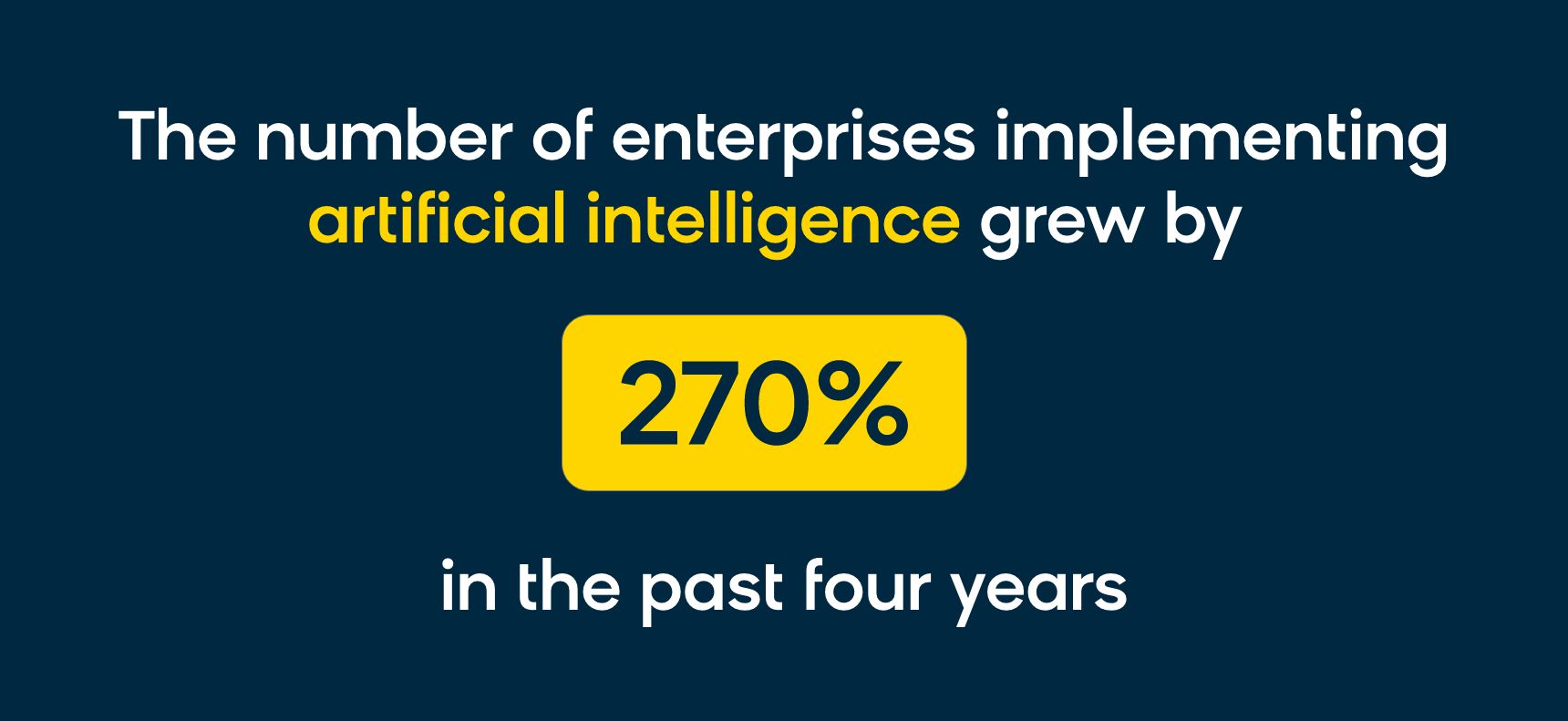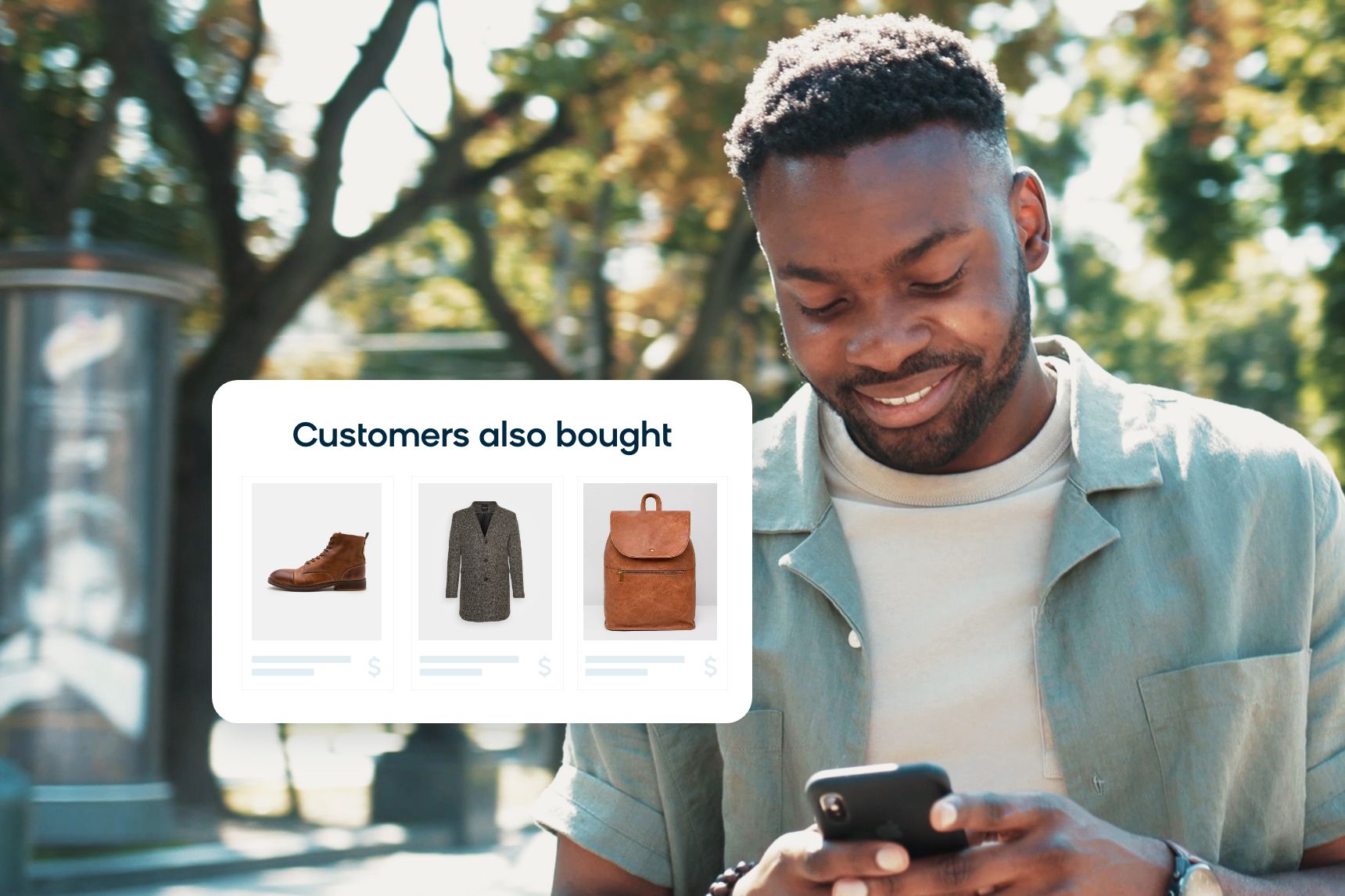8 Examples of AI in Online Shopping for a Better Customer Experience
By Ian Donnelly
09/22/2023

Artificial intelligence (AI) allows retailers to mirror the in-store experience online by answering queries, offering personalized product recommendations, and delivering a tailored service to each customer. Following the COVID-19 pandemic, which decimated the retail sector through prolonged lockdowns, McKinsey published seven imperatives for recovery. Since every imperative can be supported with AI technology, it’s perhaps unsurprising the number of businesses adopting AI has since grown by 270%.

However, despite the benefits on offer, organizations must be mindful of how they adopt AI technologies to ensure they help, rather than hinder, their success. For example, AI reduces the need for human interaction, but retailers can’t rely on technology for everything. Additionally, retailers shouldn’t lose sight of the fact that AI is only ever as good as the data it’s trained on. If the data is inherently biased, then AI will perpetuate the bias. And despite AI’s ability to deliver highly personalized experiences, only 51% of consumers trust brands to keep their personal data secure and use it responsibly.
But with all that being said, AI ultimately enables retailers to deliver the perfect omnichannel experience, allowing customers to seamlessly switch from brick-and-mortar shops to online stores and back again. From a business perspective, the intelligence gained through customer interactions across multiple touchpoints will prove invaluable when planning and executing omnichannel marketing strategies, because AI allows the business to continuously learn and adapt in the moment, which drives greater conversions, boosts cart sizes, and builds long-lasting loyalty.
In this article, we explore how AI can support online shopping and revolutionize the (virtual) high street.
Online Shopping vs. Ecommerce: What’s the Difference?
75% of consumers shop online at least once a month, but while the terms “online shopping” and “ecommerce” are used interchangeably, there is a key difference.

Online shopping involves the direct selling/purchasing of goods/services between a retailer and a consumer. In many cases, the online shop is an extension of a brick-and-mortar organization, although it can also serve a specific purpose, such as allowing a school or sports team to sell uniforms or to raise funds for a local charity. As consumers increasingly turn to the internet for shopping, it’s expected that by 2026, nearly a quarter (24%) of all retail purchases will take place online (up from 20.8% today).
Ecommerce is a platform that is specifically built to operate online. Like a marketplace, it allows multiple retailers to buy and sell online — the most successful providers being Amazon, Alibaba, and eBay. By 2026, worldwide ecommerce is expected to grow by 56% to reach $8.1 trillion (up from $5.2 trillion today).
This post focuses on online shopping while highlighting what retailers can learn from the ecommerce giants to improve their operations. Here are eight examples of how AI can improve online shopping.
Customer-Centric Search Functionality
When a website doesn’t offer a personalized experience, nearly three-quarters (74%) of customers feel frustrated, which means they’re more likely to bounce and abandon their carts.
AI supports retailers by enabling them to personalize search results in real-time, so customers feel understood and valued from their first visit. Ultimately, this leads to a 15-20% greater average order value, as well as an increase in revenue per visitor by up to 8.5%.
To achieve such a high level of personalization, AI-powered site search uses natural language processing. This analyzes customer queries to understand intent, and combines it with historical data, like past searches and purchases, to narrow and improve results. Additionally, contextual personalization scans external data, such as the current season or trending topics, to make results more relevant.

Just look at what Jenson USA, a leading online bicycle retailer in the US, was able to achieve. By creating distinct customer segments and then optimizing search results for each segment, the brand saw an impressive 26% increase in revenue per visitor.
Another big development within site search is computer vision, which allows customers to search based on images so retailers can make recommendations based on style. Ecommerce was quick to adopt computer vision capabilities and offer online features like “shop the look,” which are known to increase the average order size by 20%. Online retailers who follow in their footsteps will futureproof their customer experience, as visual search is used most by adults aged 18-34.
Voice Search Capabilities
The way consumers shop has changed. Over a fifth (22%) of customers prefer talking to an AI voice assistant over typing, and the number of consumers using smart speakers continues to rise year-on-year.
AI enables online retailers to continue meeting their customers’ expectations, as well as meet accessibility obligations with ease. Visually impaired customers no longer need to battle with screen readers and “accessible websites” because voice search can give them what they need in seconds. To take advantage, retailers simply need to optimize their website and product listings for voice search in the same way they would for SEO (search engine optimization).
Personalized Product Recommendations
Personalized shopping cart recommendations influence 92% of online shoppers to buy additional products and improve cart abandonment rates by 4.35%.
A retailer who offers personalized product recommendations shows they recognize each customer as an individual, know their interests, and value their business. AI does this by analyzing vast quantities of customer data, so at the point of purchase it can use effective sales tactics like:
- Product affinities: “Customers also bought…”
- Social proof: “70% of customers prefer…”
- Business rules: “low stock” or “top sellers”

However, personalized product recommendations aren’t just reserved for checkout — they can be used at all points of the customer journey.
According to McKinsey, personalized product recommendations deliver a 10-15% revenue lift, as well as make customers more likely to repurchase and make recommendations to friends and family. For example, worldwide cosmetics and beauty brand Yves Rocher experienced an 11x increase in purchase rate after adopting AI-powered product recommendations.
Customer Segmentation
Marketers use customer segmentation to increase campaign effectiveness, which can result in a 760% increase in revenue.
AI makes it possible for retailers to automate their customer segmentation and reveal insights that lie hidden in their data. Beyond highlighting parts of the audience that could have been overlooked, AI also creates an accurate reflection of the target audience, and allows for data analysis without assumption — for example, that young males should be the primary target for video games.
Mansion Group is an online casino business that leveraged its customer data effectively, resulting in 2x more personalized customer journeys and speeding up the time to create and execute campaigns by 8x. Retailers who take advantage of AI within their segmentation can experience a wealth of benefits, including:
- Time and cost efficiency: By automating the segmentation process, manual effort is reserved for more strategic thinking
- Enhanced precision and analysis: Detailed insights and metrics for each segment allow for more informed decision-making
- Improved personalization and targeting: Empowered through data insights, retailers can create highly personalized campaigns that resonate with the target audience
Conversational Commerce
The majority (90%) of customers expect a response to their question within 10 minutes. Thankfully, AI enables retailers to meet this expectation without the need to make customer service agents available 24/7/365.

Conversational AI can simulate human speech, offering an interactive dialogue and dynamic exchange with customers without the need for human intervention. And because the system learns from every interaction, the responses become more accurate and relevant over time. Retailers that embrace conversational commerce better understand their customers and can therefore deliver a more engaging online shopping experience. For example, we’re already seeing shopping-as-a-service rise in popularity — consumers enjoy the convenience of online shopping combined with personalized assistance because the AI understands their tastes, budgets, and needs.
Spotting Fake Reviews
Nearly every customer (99.9%) reads reviews when they shop online, and nearly half (49%) trust reviews as much as personal recommendations from friends and family. The problem with online reviews is that nearly a third (30.9%) are fake.
AI can analyze reviews for text patterns, writing styles, and formatting to identify anything that looks suspicious — for example, reviews that sound very similar to other reviews, go overboard with praise or negativity, or are one of a few positive amongst many negative. Once identified, the technology can automatically push down fake reviews and emphasize those that are verified or marked by other users as being helpful.
Dynamic Pricing
Pricing strategies are complex because they depend on multiple factors, such as competitors’ prices, manufacturing costs, and client demand.
AI helps retailers by automating the pricing process in real time, such as increasing the price when competitors are low on stock or discounting prices when the market is saturated. This enables retailers to always charge the optimal price and protect their margins.

And this isn’t anything new in ecommerce, as nearly a third (29%) of businesses are already using, or planning to use, dynamic pricing. Amazon has even used it to boost profits by 25%. Using AI will simply make this process more efficient and optimized.
Social Media Shopping Integration
Social media is an increasingly important channel for online retailers, especially considering that 43% of global shoppers research products via social networks and 29% purchase via social commerce at least once a week. However, it also holds the highest cart abandonment rate at 91% because consumers fear unprotected purchases, ineligible reimbursements, and insufficient product information.
By using AI to integrate social media shopping with retailers’ online shops, it’s possible to capture shoppers in the moment and secure the click. Rapha Racing did just this and managed to increase its purchase events seen in Facebook Ads Manager by 31%.
Furthermore, retailers can capitalize on seasonal trends — during the holiday season, 76% of consumers admit to buying something on social media. Brands can also get ahead of emerging trends like live commerce, where 72% of global TikTok users who are interested in branded content say they would also be interested in product sales.
Unlock Limitless AI Potential With Bloomreach
AI will be instrumental in helping retailers deliver truly personalized experiences in real time — and at scale. But not all AI solutions are created equal. To implement AI in online shopping effectively, you’ll need an all-in-one solution like Bloomreach. With the powerful combination of Bloomreach Engagement for omnichannel marketing automation and Bloomreach Discovery for product discovery, you’ll have everything you need to create a connected and personalized experience for every customer.
What’s more, underpinning all our solutions is Loomi, our industry-leading AI built for ecommerce. Trained on 13+ years of commerce data from some of the largest brands in the world, Loomi makes it possible to translate all your customer and product data into seamless experiences, from real-time marketing campaigns across every channel to intelligent merchandising and product discovery algorithms. Learn more about what you can do with AI and Bloomreach by exploring our use cases.
Found this useful? Subscribe to our newsletter or share it.








